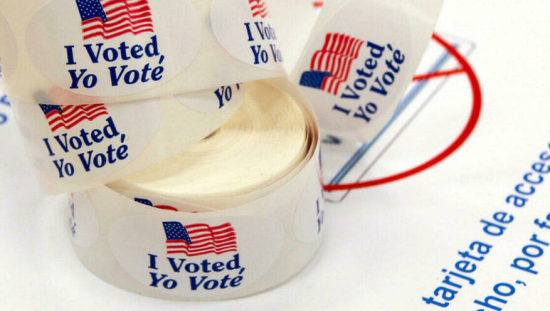The United States is the only developed nation that does not have any law guaranteeing paid family leave. This translates to many parents, particularly those from low-income families, going back to work much sooner than they should simply because they cannot afford to take unpaid leave. The benefits of paid family leave have been proven over and over again: increased worker retention rates and female labor force participation help boost the economy, and parents are allowed more time to bond with and look after their children.[1] Many countries that are part of the Organisation for Economic Co-operation and Development (OECD) provide six months or more of paid maternity leave, and a smaller but significant number provide paid paternity leave. Working parents in the U.S., however, receive nothing. Why is that?
One reason is that American democracy is essentially different from those of other countries. In his book American Exceptionalism, political scientist Seymour Martin Lipset discusses how American democracy was founded on ideas of individualism and equal opportunity.[2] Throughout American history, the concept of the American Dream has been consistently revered. In James Truslow Adams’s book The Epic of America (1931), Adams states that the American Dream is “that dream of a land in which life should be better and richer and fuller for everyone, with opportunity for each according to ability or achievement… regardless of the fortuitous circumstances of birth or position.”[3] This American Dream is rooted in the Declaration of Independence, which states that “all Men are created equal, that they are endowed by their Creator with certain unalienable Rights, that among these are life, Liberty and the Pursuit of Happiness.” Essentially, the American Dream claims that upward social mobility is—or ought to be—possible with hard work and determination, and that the potential for success lies within the individual.
In the United States, such mantras highlight how class divisions are blurred. If upward social mobility can be achieved through the power of the individual and hard work, class awareness serves little purpose. The incentive to build class power by joining labor unions, for example, is reduced by this lack of class awareness, which partially explains why labor unions in the United States are so weak compared to those of other countries.[4] This, in turn, helps explain the lack of paid leave policies, as there is less concerted support for such policies.
Along with weak labor power, corporations and businesses have great influence over American politics. Trade groups like the Chamber of Commerce at state and national levels, as well as the National Federation of Independent Business (NFIB), carry much sway in the political sphere. They have traditionally opposed government intervention in business, and thus generally oppose any government sponsored paid-leave policy.[5][6] Present day cases such as the 2010 Citizens United v. Federal Election Commission ruled that political spending is a form of speech protected under the First Amendment, and therefore corporations are able to spend large amounts of money to influence elections, giving even more power to corporations.[7]
In fact, the NFIB contributed $859,064 to specific candidates, parties, and leadership PACs during the 2016 election cycle, their top recipients being the National Republican Congressional Committee, the National Republican Senatorial Committee, the Republican National Committee, and various Republican candidates such as Barbara Comstock and Marco Rubio.[8] While $859,064 may not sound like a lot in the grand scheme of political contributions, consider the fact that the “total of contributions to candidates from National Federation of Independent Business PACs is 119 times larger than contributions from individuals.” In 2017, they spent $1,829,000 lobbying for policies that affect small businesses. They also spent $665,700 as independent expenditures to influence the outcome of the 2016 elections, directing all of that money toward Republican candidates that generally opposed government involvement in business.[9] Organizations like the NFIB influence policy, and if powerful organizations are opposed to paid leave programs on the basis that it is too much of a burden to small businesses, then it is almost impossible for such policies to even be debated in Congress.[10][11]
Another contributing factor as to why the United States does not have paid family leave laws is because of how differently World War II affected the United States versus its European allies. Europe suffered massive damage to its infrastructure, as well as higher casualty rates, as most of the war was fought on European land. Europe needed people to join the workforce in order to repair the damage and begin to rebuild. Thus, many European social democracies wanted paid leave policies in order to encourage women to both join the workforce and have children to repopulate decimated regions.[12] This was not the case in the United States. During the war, there were many women working in factories and occupying jobs that were previously held by men. When the war was over, however, men returned, and the need for women in the workforce diminished. Many of the positions occupied by women during the war were now given back to the men, and women either returned home or took on “pink-collar” jobs.[13] While it is true that the number of women who joined and stayed in the labor force increased post-WWII, most women stayed out of the workforce once they married and had children. The “cult of domesticity” that reigned during the 1950s also pressured women to keep out of the workforce, and thus reduced the need for paid leave policies.
Understanding why America doesn’t have paid family leave laws does not excuse it. Their absence means that many families, particularly low-income ones, are financially vulnerable when they have children, a time when money is needed most. The argument that it should be up to individual businesses to offer paid leave is flawed. Most private employers do not offer paid family leave, and those who do generally only cover about 13% of employees.[14] Firms usually only offer paid leave to higher-paid employees; 21% of workers in the top quarter of earners have paid leave, compared to 5% of workers in the bottom quarter of earners.[15] This means that the majority of low-income families are left struggling financially.
The current administration appears supportive of a government-mandated paid leave; the budget of the U.S. government for fiscal year 2018 includes a vague proposal for using the Unemployment Insurance (UI) system as a base for paid parental leave. It proposes that states be required to provide a minimum of six weeks of family leave. The funding for that would come from reforms to the UI system, such as by reducing waste and abuse in the program.[16] Republican Senator Deb Fischer of Nebraska also recently introduced Bill S.344, The Strong Families Act, which aims to address paid family leave. The Strong Families Act proposes an incentive program for paid family leave. Employers who provide at least two weeks of paid family or medical leave will receive a 25% tax credit for wages paid to workers taking up to 12 weeks of leave. This means that if the employer provides their employees 100% wage replacement during the paid leave, 25% of that money goes back to the employer.[17] However, this isn’t enough. As Dr. Aparna Mathur, an economist at the right-leaning American Enterprise Institute and co-director of a joint project on paid leave with the left-leaning Brookings Institution, has stated, “[the bill is] not really going to change firms’ behavior. A lot of firms are not suddenly going to start offering these policies just because now they have a tax credit in place. But what’s more likely to happen is that… firms like Netflix and Google that are already offering these policies will now just get much more money out of the federal government…”[18] She has also criticized President Trump’s plan to use the UI as a base for paid leave due to its lack of clarity on how paid leave will actually be funded.
What’s needed isn’t a vague plan on paid family leave or an incentive program, but rather a federal law that mandates paid parental leave. While it’s great that the current administration seems to be supportive of a government-mandated paid leave, this is not enough. A plan that requires businesses to offer paid family leave, a plan that is inclusive of families from all socioeconomic backgrounds, is the only kind of plan that is best for American families. As mentioned before, the United States is one of a handful of nations that does not offer paid parental leave.[19] It’s about time that the U.S. catches up to the rest of the world.
References
[1] Boushey, Heather. “Paid leave is good for our families and our economy”. Washington Center
for Equitable Growth. January 14, 2016.
[2] Kurtzleben, D. “Lots of other countries mandate paid leave. Why not the U.S.?”. NPR. July
15, 2015.
[3] Adams, James Truslow. The Epic of America. New York: Taylor & Francis, 2012.
[4] Gebelhoff, R. “Why are unions in the U.S. so weak?”. The Washington Post. August 1, 2016.
[5] “Parental Leave: What’s the Best Policy for Small Biz?”. NFIB: Protecting the Future of Small Business.
[6] “The Unintended Consequences of Paid Family Leave”. NFIB: Protecting the Future of Small Business.
[7] Oyez. Citizens United v. Federal Election Commission.
[8] Center for Responsive Politics. National Fedn of Independent Business.
[9] Ibid.
[10] “Trump’s Paid Leave Plan: Will It Hurt Small Businesses?”. NFIB: Protecting the Future of Small Business.
[11] “The Unintended Consequences of Paid Family Leave”. NFIB: Protecting the Future of Small Business.
[12] Kurtzleben, D. “Lots of other countries mandate paid leave. Why not the U.S.?”. NPR. July
15, 2015.
[13] May, Elaine Tyler. “Women and Work”. American Experience. PBS, February 9, 2004.
[14] Boushey, Heather. “Paid leave is good for our families and our economy”. Washington Center for Equitable Growth. January 14, 2016.
[15] Ibid.
[16] United States. Office of Management and Budget. Bureau of the Budget. Budget of the U.S.
Government: A New Foundation for American Greatness, Fiscal Year 2018. Washington
D.C.
[17] Strong Families Act S. 344, 115th Cong. Congressional Research Service. February 2017.
[18] Aparna Mathur (Resident scholar, American Enterprise Institute), interviewed by Chantal
Cheung, Washington D.C., February 2017, transcript.
[19] Deahl, J. “Countries Around The World Beat The U.S. On Paid Parental Leave”. NPR. October 6, 2016.



